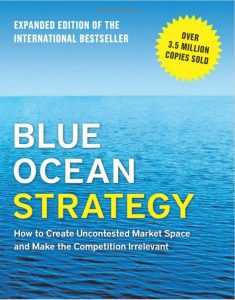The Secret to Creating a Differentiating Strategy (and why it’s difficult)
A recent article posted by Tim Williams caught my attention. It was titled: Strategy Is Deciding What Not To Do. It gets at the heart of what it takes for marketers and business leaders to create an effective differentiating strategy.
 When I first heard Williams speak (almost 20 years ago) he made a lasting impact on me when he talked about a marketing agency that specialized in Point-of-Purchase (POP) marketing for retailers. POP is all they do. In my head I was thinking, “That’s it? How do they survive?” Then Williams asked our group to guess how many employees worked at this agency. I thought maybe 50. But then I almost experienced whiplash when he replied: over 1,200 employees!!
When I first heard Williams speak (almost 20 years ago) he made a lasting impact on me when he talked about a marketing agency that specialized in Point-of-Purchase (POP) marketing for retailers. POP is all they do. In my head I was thinking, “That’s it? How do they survive?” Then Williams asked our group to guess how many employees worked at this agency. I thought maybe 50. But then I almost experienced whiplash when he replied: over 1,200 employees!!
That’s when I got serious about understanding the purpose of focus and its importance for creating competitive advantage.
Since then, I’ve come across numerous books and articles on this topic. And when it comes to competitive strategy, the leading authority here is Michael Porter. His work perfectly aligns with what Williams proposes in his article.
One of Porter’s most profound statements is one I often reference in my presentations and consulting work:
“The essence of strategy is choosing what not to do.”
Simple concept. Extremely difficult to do.
It’s like sailing in unchartered waters.
Blue Ocean Strategy
 Chan Kim and Renée Mauborgne published a book called Blue Ocean Strategy
Chan Kim and Renée Mauborgne published a book called Blue Ocean Strategy in 2005 (updated and expanded in 2015). This bestseller explains how leading companies succeed, not by battling competitors, but by systematically creating “blue oceans” of uncontested market space ripe for growth. The [Blue Ocean] strategy represents the simultaneous pursuit of high product differentiation and low cost, thereby making competition irrelevant.
This makes sense, right? Focus on profitable markets where no one else is playing, even if you have to create it.
Yet, for most business leaders it’s not that simple.
There are two major challenges with this profound concept:
- Risk. There are many unknowns (we don’t even know what we don’t know).
- Are there enough customers in this new ‘blue ocean’ to make it worthwhile?
- What kind of dangers exists that could kill a business (i.e. technical, regulatory, available resources, type of customers, etc.)?
- What’s the opportunity cost of playing in one ‘blue ocean’ while potentially missing other bigger opportunities?
- Reward. The potential financial gains are also unknown and unpredictable.
- Can an ROI and payback period even be calculated?
- Is this market sustainable, and if so, for how long?
- How probable are future revenue streams and profits?
Of course, assessing risk and reward has always been part of being a business leader. Those that choose well are rewarded well and celebrated. And those who choose poorly may never be heard from again.
A few become lengendary.
Stories of Successful Leaders
The opening story in Tim Williams’ article is very powerful. He profiles the return of Steve Jobs to Apple in 1997 when 300+ projects were suddenly scrapped and just four became the company’s focus – two in the home computer market and two in the business market. The powerful concept of focus was inherently understood by Jobs. He also happened to pick the right ‘blue oceans’ to play in.
Williams underscores the importance of this bold move by highlighting the fact that the market value of Apple is at $760 billion today, the most valuable company in the world. Apple also only has 200 SKUs, compared to 15,000 SKUs at HP. Clearly Jobs got it right.
Another leader who is often celebrated for getting it right is Jack Welch. When Welch took over as CEO of General Electric in 1981, he reduced the number of business units from 348 to 14, selling off many assets. His simple mandate was that GE must be #1 or #2 in the industries it played in. The rest had to be eliminated.
This process of focusing reduced the total number of employees from 411,000 to 299,000. In addition, using the funds from the sale of assets, Welch then invested $18 Billion in the 14 remaining business units and strengthened them with $17 Billion worth of acquisitions.
What was the end result for GE? During Welch’s tenure, the valuation of the company rose 4000%, from $12 billion to $280 billion.
How do such leaders manage to get so focused AND remain focused?
A Focusing Secret
One secret Tim Williams suggests is this:
The essence of a business strategy should fit on one sheet of paper.
Williams goes on to suggest five elements that should be included in the business strategy (which I’m sure maps to his company’s consulting process). Other consultants follow a similar model, including Gino Wickman in his book Traction where he outlines his “entrepreneurial operating system” (EOS) that’s on a single page.
Lastly, Williams proposes 3 questions to vet and validate the final strategy:
- Does it help the business say no to the wrong prospects?
- Does it create strong barriers to entry?
- Does it result in fewer competitors?
Here, I would add a fourth question to ensure the business strategy endures for the long term:
- Does it align with the strengths of the business?
When the business strategy aligns with existing strengths, it fuels peoples’ passion. At this point, purpose becomes clear, and employees (including leaders) are motivated and engaged.
Bottom line: when a business leader faces the challenge of trying to create a unique, relevant, and profitable position in a competitive marketplace, the secret is to decide what NOT to do, and then write the differentiating strategy on a single sheet of paper.
————————
What will you choose to NOT do?









